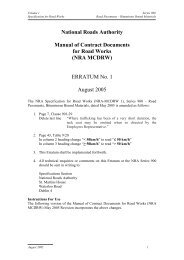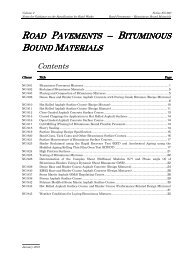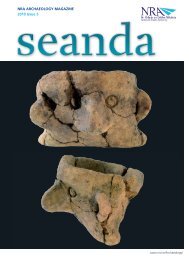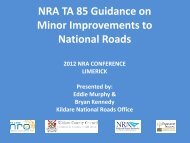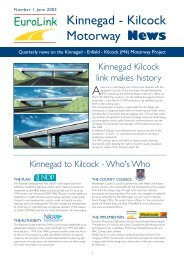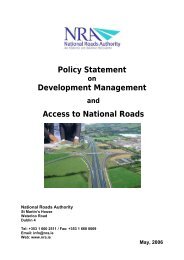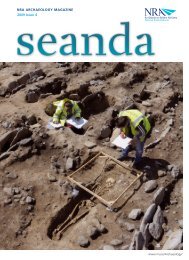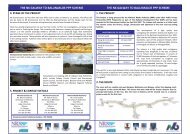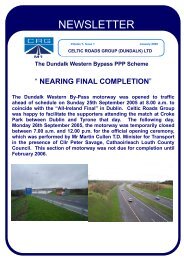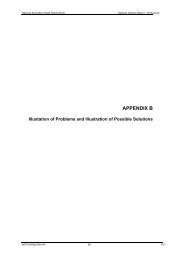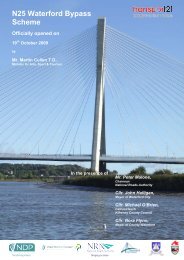Guidelines for the Treatment of Badgers Prior to - National Roads ...
Guidelines for the Treatment of Badgers Prior to - National Roads ...
Guidelines for the Treatment of Badgers Prior to - National Roads ...
Create successful ePaper yourself
Turn your PDF publications into a flip-book with our unique Google optimized e-Paper software.
10<br />
GUIDELINES FOR THE TREATMENT OF BADGERS<br />
PRIOR TO THE CONSTRUCTION OF NATIONAL ROAD SCHEMES<br />
BADGER UNDERPASSES<br />
The majority <strong>of</strong> badger road casualties occur where<br />
traditional badger paths cross roads. Where badger<br />
pathways cross a proposed new road, where feasible, a<br />
badger underpass (as outlined in Figure 1) should be<br />
provided at <strong>the</strong> location <strong>of</strong> each <strong>of</strong> <strong>the</strong>se pathways. The<br />
underpass is usually a 600mm concrete pipe, but may <strong>for</strong>m<br />
part <strong>of</strong> a watercourse culvert or bridge. <strong>Badgers</strong> are guided<br />
in<strong>to</strong> <strong>the</strong> underpasses by mesh fencing, which also prevents<br />
<strong>the</strong>m entering directly on<strong>to</strong> <strong>the</strong> road. The lower part <strong>of</strong><br />
<strong>the</strong> fence is buried <strong>to</strong> prevent badgers digging under<br />
<strong>the</strong> fence.<br />
Where an underpass cannot be provided at <strong>the</strong> exact<br />
location, it should be sited as close as feasible <strong>to</strong> <strong>the</strong><br />
existing pathways across <strong>the</strong> proposed road route,<br />
preferably following wildlife corridors, e.g. hedgerows.<br />
There will usually be a requirement <strong>to</strong> provide more than<br />
one underpass - should <strong>the</strong>re be numerous pathways<br />
intersected by <strong>the</strong> proposed road. The number and<br />
location <strong>of</strong> underpasses will need <strong>to</strong> be assessed on a site-<br />
by-site basis. The underpasses should be installed at <strong>the</strong><br />
earliest possible stage in construction and appropriate<br />
permanent badger-resistant fencing erected <strong>to</strong> encourage<br />
<strong>the</strong> badgers <strong>to</strong> utilize <strong>the</strong>m. Where feasible, permanent<br />
fencing should be erected immediately following underpass<br />
construction. In addition <strong>to</strong> <strong>the</strong> specifications outlined in<br />
Figure 1, <strong>the</strong> following guidelines should be followed in<br />
construction <strong>of</strong> an underpass:<br />
• The exit and entrance <strong>to</strong> tunnels should be flush with<br />
badger-pro<strong>of</strong> fencing and <strong>the</strong> invert set at ground<br />
level. A concrete surround will provide a solid<br />
connection <strong>to</strong> <strong>the</strong> uprights <strong>of</strong> <strong>the</strong> fence and inhibit any<br />
ef<strong>for</strong>ts <strong>to</strong> dig. Drainage should be adequate <strong>to</strong><br />
prevent waterlogging at <strong>the</strong> entrances and within <strong>the</strong><br />
underpass.<br />
• Where stream culverts are being laid, structures<br />
greater than 1m in diameter/width should be fitted<br />
with a raised mammal ledge along one or both sides<br />
(where recommended by <strong>the</strong> wildlife experts; see<br />
<strong>Guidelines</strong> <strong>for</strong> <strong>the</strong> Crossing <strong>of</strong> Watercourses During <strong>the</strong><br />
Construction <strong>of</strong> <strong>National</strong> Road Schemes, <strong>National</strong> <strong>Roads</strong><br />
Authority, 2005). The ledge should be elevated above<br />
normal flood levels. An alternative approach <strong>to</strong> <strong>the</strong><br />
provision <strong>of</strong> a ledge is a separate pipe culvert<br />
(600mm) set above flood level adjacent <strong>to</strong> <strong>the</strong> stream<br />
culvert. Badger-resistant fencing and landscaping<br />
measures will be required <strong>to</strong> guide animals <strong>to</strong> <strong>the</strong><br />
culvert.<br />
• The entrances <strong>to</strong> <strong>the</strong> underpass may be planted with<br />
appropriate hedgerow planting (e.g. holly, hawthorn<br />
and blackthorn) <strong>to</strong> encourage badger use (see<br />
A Guide <strong>to</strong> Landscape <strong>Treatment</strong>s <strong>for</strong> <strong>National</strong> Road<br />
Schemes in Ireland, <strong>National</strong> <strong>Roads</strong> Authority, 2005).<br />
Such planting should not obscure <strong>the</strong> entrances <strong>to</strong><br />
<strong>the</strong> underpass.<br />
GUIDELINES FOR THE TREATMENT OF BADGERS<br />
PRIOR TO THE CONSTRUCTION OF NATIONAL ROAD SCHEMES<br />
BADGER-RESISTANT FENCING<br />
The requirements <strong>for</strong> badger-resistant fencing are specified<br />
in Figure 2. Fencing is required <strong>to</strong> prevent badgers from<br />
crossing <strong>the</strong> road at points o<strong>the</strong>r than at <strong>the</strong> underpasses<br />
provided. The fencing must extend <strong>to</strong> a sufficient distance<br />
from underpasses <strong>to</strong> ensure that badgers will not find easy<br />
ways around <strong>the</strong>m. Underpass entrances should be<br />
recessed in <strong>the</strong> fence line, <strong>the</strong>reby guiding animals <strong>to</strong> <strong>the</strong>m.<br />
The extent <strong>of</strong> fencing proposed <strong>for</strong> a scheme should be<br />
determined by <strong>the</strong> locations at which badgers are likely <strong>to</strong><br />
encounter it and <strong>the</strong> frequency with which <strong>the</strong>y would be<br />
expected <strong>to</strong> attempt <strong>to</strong> cross <strong>the</strong> road. As badgers are<br />
found throughout most <strong>of</strong> <strong>the</strong> Irish countryside, it may<br />
<strong>of</strong>ten be necessary <strong>to</strong> incorporate badger-resistant fencing<br />
As badgers are found<br />
throughout most <strong>of</strong> <strong>the</strong><br />
Irish countryside, it may<br />
<strong>of</strong>ten be necessary <strong>to</strong><br />
incorporate badgerresistant<br />
fencing along<br />
continuous lengths <strong>of</strong><br />
<strong>the</strong> road.<br />
11<br />
along continuous lengths <strong>of</strong> <strong>the</strong> road. It is <strong>of</strong> particular<br />
importance <strong>to</strong> avoid gaps or weak points in fencing at<br />
awkward features such as undulating ground or streams as<br />
badgers may exploit such weaknesses, thus negating <strong>the</strong><br />
effectiveness <strong>of</strong> fencing. Badger-resistant fencing should<br />
never be installed asymmetrically; it should be installed in<br />
parallel on both sides <strong>of</strong> <strong>the</strong> road and care taken <strong>to</strong> avoid<br />
any gaps, which may occur where fencing abuts o<strong>the</strong>r<br />
features such as hedgerows, footbridges, gates or stiles.<br />
The constructed underpasses and badger-resistant fencing<br />
at all sites should be checked <strong>to</strong> ensure compliance with<br />
<strong>the</strong> specifications.






